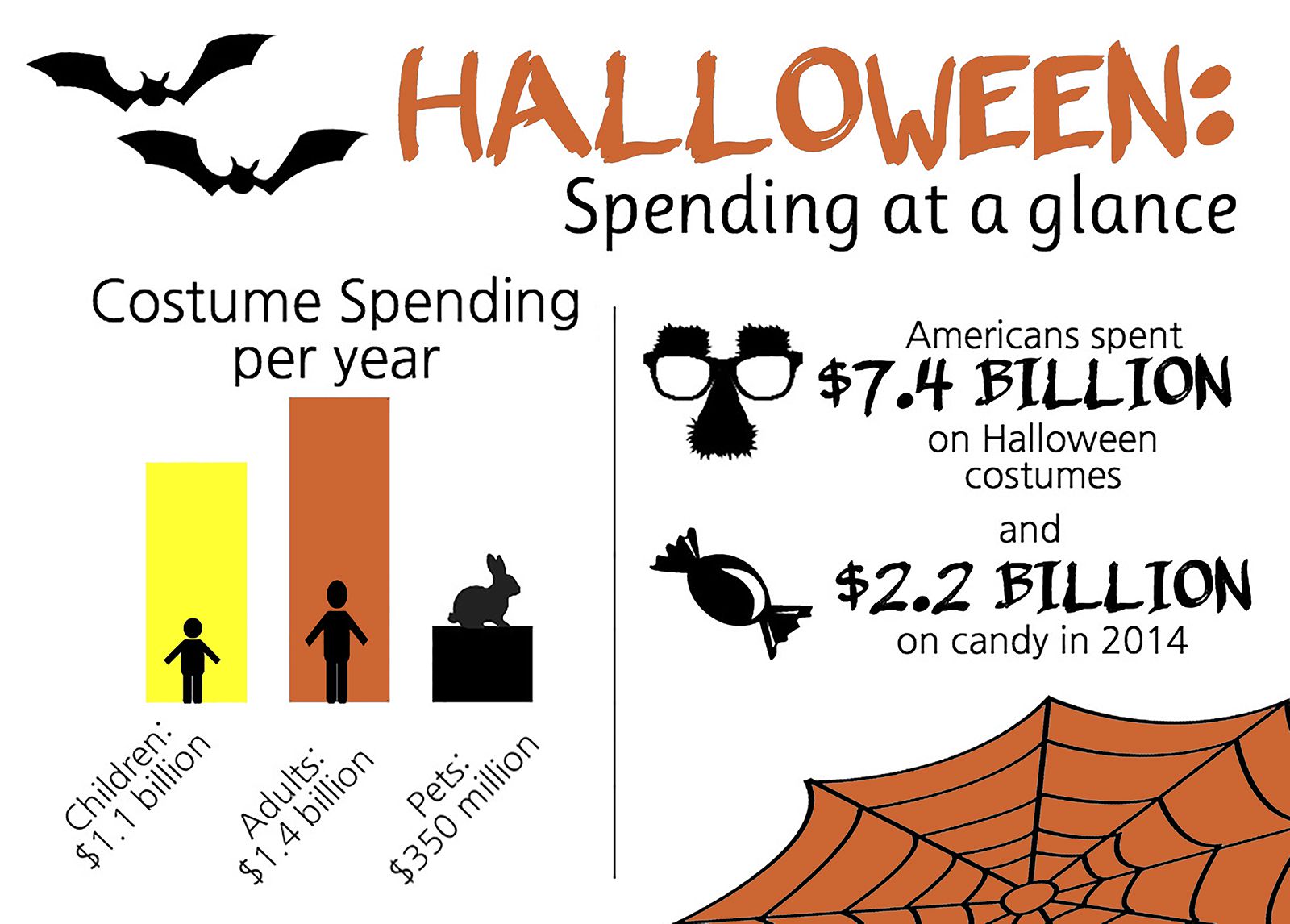Leaves have started falling, the air is getting colder and pumpkins are appearing in windows and on doorsteps throughout Boston, all signaling that Halloween is just around the corner. And if you have spent a lot of time — and money — on the perfect costume this year, you are certainly not alone. Although Christmas is usually the holiday associated with massive spending and overconsumption, Halloween is on track to becoming one of the largest consumer holidays of the year.
According to the National Retail Federation’s annual Halloween Consumer Spending Survey conducted by Prosper Insights & Analytics, 67.4 percent, or more than two-thirds, of Halloween celebrants will purchase Halloween costumes, which is the highest percentage in the survey’s 11-year history. Additionally, the average person is predicted to spend $77.52 on Halloween this year, compared to $75.03 reported on last year’s survey.

More specifically, the survey reported that $1.1 billion will be spent on children’s costumes, $1.4 billion will be spent on adult costumes and $350 million will be spent on pet costumes, contributing to a total of $2.8 billion in Halloween costume spending.
These robust numbers are indicative of a stronger economy and of the increase in variety of costumes, said NRF President and CEO Matthew Shay in a press release on Sept. 24.
“There’s no question that the variety of adult, child and even pet costumes now available has driven the demand and popularity of Halloween among consumers of all ages,” he said. “As one of the fastest-growing consumer holidays, Halloween has retailers of all shapes and sizes preparing their stores and websites for the busy fall shopping season.”
One of the busiest Boston Halloween costume haunts is Boston Costume in Cambridge, which is housed in the bottom floor of the Garment District, a vintage clothing retailer. Meryl Tochen, a Garment District employee, said the average customer spends $40 on a costume at their store, which is comparatively less than the $77.52 the NRF survey predicted.
“During the October season, we sell packaged costumes, costume accessories, hats, wigs, makeup, shoes [and] hand-held costume props as well as used costumes and clothing,” she said.
College students are one of largest demographics for the Garment District’s Halloween costumes, Tochen said.
“The average customer year-round, and especially during Halloween, is a college student,” she said. “However, we do have a very diverse customer base overall.”
Although the NRF survey reported that only 16 percent of people will draw from popular culture to find inspiration for their costumes, Tochen said the costumes in-demand at the Garment District reflect a great interest in popular culture.
“‘Orange Is the New Black’ seems to be the popular costume this year,” she said. “Staples like flapper dresses and pirate outfits are also quite popular this year.”
Richard Lamoretti, owner of Fast Eddie’s Barber Shop in Allston, takes a more novel approach to the hair-raising holiday. Lamoretti transforms his space and that adjacent to his shop into Halloween pop-up shop, Allston Costume, and has been doing so for eight years now. Lamoretti said during Halloween season, Allston Costume experiences a three-day rush in sales in the days preceding Oct. 31.
But even despite this small window for Halloween sales, Lamoretti said many major retailers are too keen on pushing holiday products on consumers prematurely.
“Go into Kmart, go into all the stores [and] they already have Christmas stuff out,” he said.
Contrary to the NRF’s survey results, several Boston University students said they are taking the frugal approach to Halloween spending this year.
Vipul Patel, a sophomore in the College of Arts and Sciences, said he plans to cut back this Halloween.
“[I will] try to go as cheap as possible,” Patel said.
Rather than spending money on a pre-made costume, he said he plans to craft his own costume using material he already owns. Patel said he predicts that much of the BU population would most likely follow his lead.
This do-it-yourself attitude is reflected at Goodwill, said James Harder, director of communications at Morgan Memorial Goodwill Industries.
“We do sell some ready-made costumes,” he said. “But for the most part, a Goodwill Halloween has a do-it-yourself mentality. It’s really creative, and it’s not cookie cutter. A lot of students want to have a great costume that no one else will have.”
Goodwill, which has locations in several college-area neighborhoods including Allston, Somerville and Cambridge, is geared toward Boston’s student population, Harder said, and usually sees a spike in business within the two weeks leading up to Halloween.
“Goodwill is extremely popular for Halloween shoppers. It’s our Christmas, if you will,” he said.
The low prices are a draw for students, Harder said, who should be able to find a costume at Goodwill for less than $20.
Riley Driscoll, a sophomore in the College of Arts and Sciences, said she was surprised by the NRF survey’s finding that Americans are expected to spend over $70 on a costume.
“That is a crazy statistic,” she said. I’m not going to spend that much, and I think most BU students would spend no more than $20. I’m going to go to Goodwill [to search for my costume].”
Another added bonus of finding a costume at a thrift store like Goodwill, Harder added, is the ability to give it all back once the candy is eaten and pumpkins are put away.
“As a bonus, once you have worn a costume, you can donate it back to Goodwill,” he said. “You can come into Goodwill, purchase your costume, and then the next day, you can re-donate it and help out the environment.”
Olivia Deng contributed to the reporting of this article.
















































































































